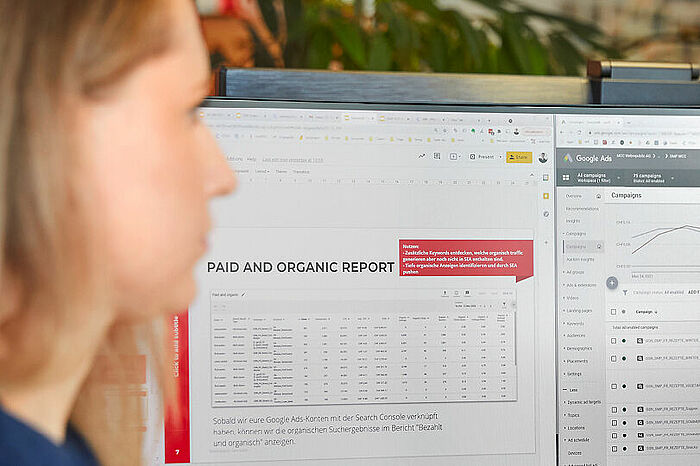Lasting and unique experiences are becoming increasingly central for customers, across all channels and platforms. This development is also increasingly influencing the user experience (UX). To optimize the UX, it is essential to understand user behavior. We show how this can be achieved.
A website is both a company's business card and the key to conversions. For these to succeed, websites should be regularly optimized and updated. It has become indispensable to consider users during optimization: How do they behave on the website? How are conversions completed? What is the website user flow like? As soon as we understand how users behave on a website, we can derive measures for the UX - and define rules, standards, and methods. You can discover what these can look like in this article.
Data-driven UX design: an integral part of the user experience
The most effective way to understand user behavior is to collect data and interpret it. Data trends related to conversions, page views, and other user actions form the basis for defining UX design opportunities. This data helps teams understand their target audience and illustrates that the work being done is on the right track. The obtained values reveal information about user vulnerabilities, discover new trends, and support data-driven UX design. Quantitative data sets, for example, additionally provide an attractive basis for decision-making: They can support UX optimizations with quickly visible results and generate attention among various stakeholders in the company. A well-crafted process includes measuring the experience itself because UX insights can be reflected only in tangible data. User behavior and response help UX designers validate findings, hypothesize ideas, and measure results.
Data-driven UX is the foundation for the following design components:
● Basic personas / target groups
● Designing user flows
● Redesigning an effective UX
● Conducting a heuristic evaluation
● Optimizing the conversion funnel
● Creating user-centric content for the website
Data collection in UX: quantitative or qualitative?
Data collection for UX optimization can be done both qualitatively and quantitatively. Quantitative data provides information about what actions users take when using a product. Qualitative data provides information about why they do so and how they perceive the experience on a website. Therefore, it is important to consider both methods when making design decisions. Below we listed some methods in both the quantitative and qualitative realms.
Quantitative Data Collection
There are many ways to get quantitative data for UX. How users interact with a website can be efficiently discovered via tools like Google Analytics, Google Optimize, and other measurement tools (e.g. Hotjar, Crazy Egg, Optimizely, UserTesting). This type of data shows numerically who is interacting on a page, what is happening, and when it is happening. The following methods are useful for collecting quantitative data on UX.
Methods:
● A/B testing
A/B and multivariate tests can elicit how different versions of a website or app perform compared to each other. The results help to significantly improve the user experience and optimize user behavior. Continuously running A/B tests to improve a design can lead to a significant increase in conversions.
● Behavior Flows
Behavior Flows show the paths users take through a website or app - from entry to the last page before they leave a website. They also illustrate what content on the website users interact with. Behavior Flow can also help identify potential content issues.
● Surveys
UX surveys offer a quick and relatively easy way to collect data about (potential) users. They are an effective way to gather feedback on a live product, research a company's USP, conduct a contextual survey, refine a new feature, or reduce the risk of an unsatisfactory solution.
Qualitative data collection
Qualitative data shows us how and why users act on a website. Why does a particular group of users perform an action? Why does one piece of content keep visitors on the site longer than another? Where is the bounce rate particularly high?
Qualitative data helps us understand not only what happened, but why and how it happened. Qualitative data is often prepared using personas, journey maps, or empathy maps.
Methods:
- User Journey/Flows
User journeys/flows visualize in model form how users interact with a website or app. They support the design of user interactions with the website or app. Information collected from user flows helps to identify potential weaknesses or is a starting point for further investigations through A/B tests or user interviews.
- Competitor analyses
Competitor analysis compares your own main competition and UX best practice company with your own company. But be careful: Simply imitating competitors or UX pioneers is not always an effective solution. Competitor analyses primarily serve as a source of inspiration and show weaknesses in the competition, which should be used to one's own advantage.
- Usability testing
Usability tests can assess how easy a design solution is to use. This allows additional assumptions about user behavior to be tested with real test subjects and applied to the further development of the website or app.
Patience for a sustainable business impact
The most important prerequisite for getting started with data-driven UX design is patience: It takes time to turn the elicited data into results and reap the rewards of this work. UX optimizations need to be continuously monitored and the market reaction to the changes critically considered.
Regardless of business goals, data-driven UX helps improve product performance, increase conversions, and better meet user needs. In this way, one can increase ROI through improved UX and strengthen overall product usage and adoption. Additionally, by using quantitative and qualitative data, business decisions can be better influenced and decision makers can be convinced of the need for optimization. UX is an iterative process that needs to be nurtured.




